Foreign carmakers have been quick to seize the opportunity of using India as an export base for small cars. Since 1998, policies in India have supported wholly-owned vehicle manufacturing facilities allowing foreign carmakers to set up shop without fear of compromising revenue with a joint-venture partner, or having to share important technology blueprints.
Plus the added knowledge that, as India’s vast population steadily moves from rural to urban lifestyles with rising incomes, demand for vehicles will continue to grow. So setting up large automotive manufacturing plants with capacity in excess of domestic demand has also allowed global automakers to use India as a low-cost production hub, mainly for export to Europe.
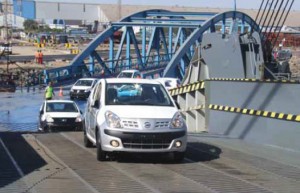
“Europe will remain a major export market for light vehicles made in India, supported by shipments to other countries in Asia Pacific, the Middle East and Africa. It is unlikely that Indian vehicle makers will export to North America in a big way, largely because of a limited demand for small cars,” writes Ammar Master from JD Power and Associates, in an editorial in the latest India Automotive Monthly report.
In 2009, 428,000 small cars were exported from India (according to data provided by JD Power), and in 2010 performance in the first quarter has remained very strong, with total vehicle exports of 122,059 units, almost double the exports in the same time period last year.
The main small car exporters are foreign carmakers who have wholly owned or majority owned facilities in India. India has a very liberal policy today so there is no restriction for foreign carmakers to create joint ventures with local partners. “After 1998 the entire system was liberalised–there is no restriction on ownership–some companies do have joint ventures out of convenience,” says Frost and Sullivan’s automotive guru, VG Ramakrishnan.
The Big Two versus home-grown talent
Korean carmaker Hyundai Motor India has exported 68,885 vehicles in the first quarter of this year, followed by Maruti Suzuki with 42,040 units. Hyundai Motor India is a whollyowned subsidiary of Korean carmaker Hyundai, and Maruti Suzuki is a subsidiary of Japanese carmaker Suzuki, which owns 54.2% of the company.
In February this year Hyundai began exporting cars from India to Australia–a new market for the carmaker. In fact, Hyundai India has reached cumulative exports of 1m cars within around a decade from opening a plant in India. (Or 10 lahk in the Indian numbering system, where a lakh is a unit equal to one hundred thousand.)
Of India’s home-grown brands Tata Motors has exported 7,176 units and Mahindra & Mahindra have exported 3,619 in the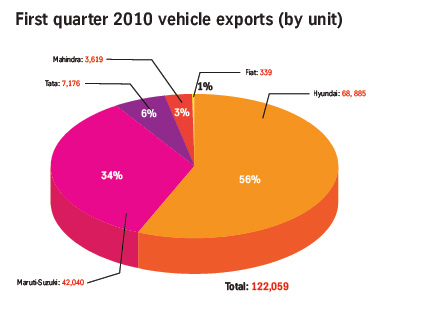 first quarter. But the new kid on the block for small vehicle exports will be Japanese carmaker Nissan.
first quarter. But the new kid on the block for small vehicle exports will be Japanese carmaker Nissan.
Nissan is shifting production of its small car, Micra, to India from current production bases in the United Kingdom. Production of the Micra for the Indian market will begin in May at Nissan’s joint plant with Alliance partner Renault, in Chennai, while export versions will be rolled out by the second half of the year. “We believe Nissan will export about 35,000 Micras this year, which will go up to 125,000 units in 2011, accounting for 85% of its production,” says Master.
Any port in a boom?
So which ports are these vehicle exporters using? There are only three designated ports for vehicle exports, according to Ramakrishnan. These are Mumbai Port, Mundra Port in Gujarat and Chennai Port in Tamil Nadu. Hyundai uses the port down south in Chennai, close to its production facility. Maruti Suzuki uses the port in Gujarat–Mundra Port, while Tata Motors uses the port in Mumbai. But competition among the ports is gaining momentum and private investors are building up strong port facilities, which will, in future, make carmakers rethink their choice of export hubs.
Maruti Suzuki exports from Mundra Port in Gujarat state as Maruti Suzuki has made investments in a new port and car handling facility here, while Hyundai ships vehicles from the Chennai Port, Master reveals. “The most important reason for them to use these ports is that they are closest to their manufacturing facilities. In fact, the production locations were chosen keeping these ports in mind,” he says.
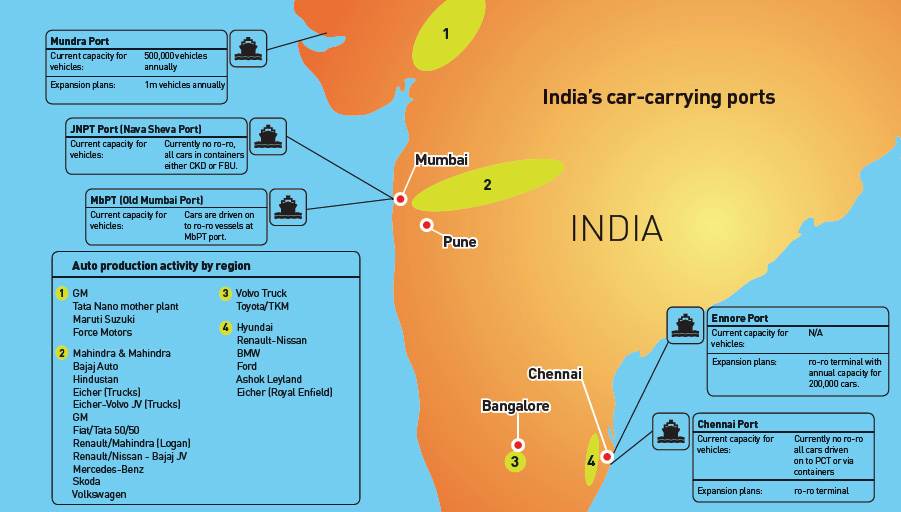 For vehicles leaving India there are a few simple choices–to export a fully built car, or to export the car in parts; and whether to use specially designed passenger car carriers, or to use containers. Many carmakers in India still use containers to ship finished vehicles, says VG Ramakrishnan, as ro-ro terminals are still being developed. Carmakers generally choose the port that is closest to their production base, but will that change as facilities at more distant ports develop?
For vehicles leaving India there are a few simple choices–to export a fully built car, or to export the car in parts; and whether to use specially designed passenger car carriers, or to use containers. Many carmakers in India still use containers to ship finished vehicles, says VG Ramakrishnan, as ro-ro terminals are still being developed. Carmakers generally choose the port that is closest to their production base, but will that change as facilities at more distant ports develop?
Mumbai Port
The port in the Indian capital of Mumbai is made up mainly of two major ports: the newer Jawaharlal Nehru Port, known as JNPT at Nhava Sheva, and the Old Mumbai Port, referred to as MbPT. The JNPT port in Mumbai is run by the Mumbai Port Trust and is the country’s largest container port. The port is so busy that it is common to wait long hours to reach the waterfront. “JNPT is completely jam-packed so you have to wait for eight hours sometimes,” says Ramakrishnan. The port has no ro-ro facilities and there is inadequate parking or warehousing, making it nearly impossible for passenger car carriers to stop at this port. “As a business strategy I don’t think Tata will export CBUs (complete built units) as JNPT couldn’t handle it,” he continues.
Other analysts echo this opinion. “Our belief is that Nano Europa will be initially exported in CBU form,” confirms Master. However, ro-ro vessels do dock at the Old Mumbai Port. Anil Varma, who heads up NYK Line’s passenger car carrying lines in India says NYK Line’s pure car carrying vessels dock at the MbPt Port, where cars are then driven onto the vessels. Tata mainly uses this port. “As our manufacturing plants are based at western, northern and eastern regions of India, we use Port MbPT and occasionally Port Mundra,” says Tata Motor’s Prakash Shende, who heads up Tata Motor’s international supply chain management. Local carmaker Tata Motors exports to more than 35 countries, says Shende. “For finished-goods-status cars that are to be exported we use Port MbPT, because the required vessels call at that port,” he explains. However as the Nano’s production base has been shifted to Gujarat it is generally thought that Tata will use Mundra Port to export the Nano small cars.
That is precisely what Ramakrishnan predicts for Tata and Mundra Port, as this makes logistical sense with the Nano production base in Sanand, Gujarat.
Mundra Port
The newly developed car terminal at Mundra Port is mainly used by Japanese carmaker Suzuki Motors for the export of its cars from Maruti Suzuki India. The Mundra Port is a privately owned port which has specially built facilities for finished vehicle exports as well as links to rail networks. Mundra Port has an annual capacity to handle half a million vehicles says Mitul Parekh, of Mundra Port and special economic zone. The current annual capacity for finished vehicles at Mundra Port is 500,000 units, says Parekh. In 2009 the port exported 130,000 cars.
Parekh believes that Mundra Port is South Asia’s first pontoon-based auto terminal; it also operates around the clock, for a full 24 hours. The port has car washing facilities where all cars are washed prior to loading as well as 10 acres for parking vehicles before loading. And Mundra Port is expanding. “We are looking at new berths and an expanded yard to increase the capacity to handle one million cars,” says Parekh.
Mundra Port’s special automobile terminal is called the Adani Mundra Automobile Terminal and it has its own logistics handling company to manage transhipment of finished vehicles. “Adani Logistics, a subsidiary of Mundra Port and Specia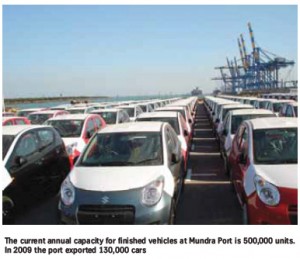 l Economic Zone [SEZ], specialises in automotive logistics and uses the safest and the most reliable infrastructure for transporting cars in containers,” says Harikrishnan Sundaram from Mundra Port and SEZ.
l Economic Zone [SEZ], specialises in automotive logistics and uses the safest and the most reliable infrastructure for transporting cars in containers,” says Harikrishnan Sundaram from Mundra Port and SEZ.
Plus the port has links to India’s rail network. “Mundra Port is well connected by rail by a private railway line of 64km to the nearest Indian Railway network,” says Sundaram. “The port also regularly handles the auto wagons of Indian Railways that carry Maruti Suzuki cars from their plant at Gurgaon,” he says. The majority of Maruti Suzuki vehicles arrive via rail to the port, just over 50%, says Mundra Port’s Mitul Parekh. Mundra Port has given Maruti Suzuki a special designated area for pre-delivery inspection. “The port has given land to Maruti Suzuki India, which has set up a pre-delivery inspection (PDI) facility for their export vehicles. The PDI facility is spread over an area of 35 acres and can park up to 10,000 vehicles,” says Sundaram.
Mundra Port is also planning to expand beyond Gujarat. “We are looking for opportunities in other parts of the country and the world and will definitely look towards opening other terminals,” says Parekh. Japanese shipping line NYK Line is also keen on expanding with a specialised car terminal at Mundra Port, says Anilkumar Varma, assistant general manager from NYK Line (India). In the meantime, competition lurks down south as Chennai boosts infrastructure with private investors ready to push vehicle export volumes from the region.
Chennai Port
This port covers a 60km automotive corridor with various global carmakers’ production plants located nearby. The corridor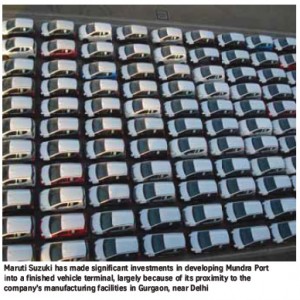 stretches from Gummidipoodi, which is 50km north of Chennai, to Maraimalai Nagar, which is 35km south of Chennai and is served by tow ports: the Chennai and Ennore Ports. Industry estimates put vehicle production along this corridor at 1.25m passenger vehicles by 2012. The corridor houses all the big names: BMW, Ford, Hyundai, Renault and partner Nissan, Mitsubishi Motors, as well as industrial and commercial vehicle manufacturers such as Komatsu, Caterpillar and Caparo Group.
stretches from Gummidipoodi, which is 50km north of Chennai, to Maraimalai Nagar, which is 35km south of Chennai and is served by tow ports: the Chennai and Ennore Ports. Industry estimates put vehicle production along this corridor at 1.25m passenger vehicles by 2012. The corridor houses all the big names: BMW, Ford, Hyundai, Renault and partner Nissan, Mitsubishi Motors, as well as industrial and commercial vehicle manufacturers such as Komatsu, Caterpillar and Caparo Group.
“Hyundai uses the Chennai Port to export all finished vehicles,” says V Anand, the general manager of sales and logistics at Hyundai Motor India. He continues: “It is the nearest port and is conveniently located at a distance of about 40km from the plant with all the basic facilities like deep draft for handling the most modern ro-ro car carriers of over 6,500 cars capacity.”
“In 2009, 52% [289,863 cars] were sold in the domestic market and 48% [270,007 cars] were exported to more than 115 countries across the globe,” says Hyundai’s Anand. Anand explains the key reasons why Chennai port has been chosen as the port for all Hyundai’s finished vehicle exports from India: Hyundai’s plants are just down the road from the port. “Hyundai has currently two plants in the same location, both located at Sriperumbudur, about 40km from Chennai City,” he says. The plants have their own warehousing facilities and can hold up to 30,000 vehicles.
Chennai boasts a draft of 14 meters, which means that it is able to handle the most modern ro-ro vessels. The West Quay is dedicated for car carriers, where length along the axis is also not an issue. The port also claims that are no tidal effects to impact the loading and unloading operations. Chennai also has skilled drivers specially trained to handle cars of varying sizes, transmissions as well as left-hand or right-hand drive, and can load cars at an average efficiency of around 300-350 cars each hour.
However the port suffers from congestion and inadequate parking facilities, according to Hyundai’s V Anand. “Storage facility currently exists for about 4,500 cars,” he says “This is inadequate but plans are there to have multi-level car parking in about three years, as expanding in the horizontal dimension is no longer possible due to paucity of space.” The congestion within the port is yet another challenge. To tackle the issue for future growth, the port has several plans, including developing entry through multiple gates into the port based on the cargo. It also points to several infrastructure projects in the pipeline, including building an elevated corridor project from Maduravoyal as well as the Ennore Manali Road projects.
Ennore Port Just 24km north of the port of Chennai is Ennore Port. There are various plans on the go for the development of both Chennai and Ennore ports into international standard ro-ro terminals. Many of the carmakers with production plants in the area are keen to join forces to minimise costs. “Nissan has started its first trial exports with six cars from Ennore Port this April,” says Ammar Master, “Nissan signed a MoU with Ennore Port in 2008 to export cars out of here. The Port is developing a berth space for Nissan that will be completed in June. While domestic sales are expected [to begin] in July, exports will commence shortly after as Nissan ramps up production.”
Just 24km north of the port of Chennai is Ennore Port. There are various plans on the go for the development of both Chennai and Ennore ports into international standard ro-ro terminals. Many of the carmakers with production plants in the area are keen to join forces to minimise costs. “Nissan has started its first trial exports with six cars from Ennore Port this April,” says Ammar Master, “Nissan signed a MoU with Ennore Port in 2008 to export cars out of here. The Port is developing a berth space for Nissan that will be completed in June. While domestic sales are expected [to begin] in July, exports will commence shortly after as Nissan ramps up production.”
But by the end of this year Ennore Port is likely to begin use of a ro-ro terminal says NYK Line’s Anilkumar Varma. “Ennore port is coming up with a ro-ro terminal at the end of this year for Toyota and Nissan,” he says. The terminal is expected to have capacity for 200,000 cars annually. “For future growth, ports such as Chennai/Ennore are important if they are cost effective for supply chain total cost for finished vehicles,” says Tata Motors’ Prakash Shende. For this, however, the ports need “safe and secured parking along with free parking time at the port with ease in export document process as essential factors,” he says.
As investments increase and more carmakers begin production hubs along this corridor from Gummidipoodi to Maraimalai Nagar, some have begun to call this corridor packed with vehicle production plants the “Detroit of Asia”, but Frost and Sullivan’s Ramakrishnan does not agree. “Detroit is a decaying city–a ghost town in my opinion–it is not the pinnacle of the automotive industry anymore,” he says. “So giving an upcoming city a decaying city’s name is just not on.”
The future
Today there are no fully fledged ro-ro ports in India. However as the export of vehicles increases, shipping lines and carmakers will privately invest to build them with or without government investments. “There are no entirely new ports being developed,” says Ammar Master. “What is happening is that the existing port authorities are actively expanding and upgrading their infrastructure to meet the future growth of vehicle exports. Vehicle manufacturers are also investing in developing the infrastructure for exporting cars to improve their efficiency.” But a big question for future years, which everyone is speculating about, is whether Tata Motor’s Nano will become the big export product from India. Will the little Nano made by India’s Tata Motors really beat the huge export numbers from Korean and Japanese carmakers in India? “It is very unlikely that Tata Nano will beat Hyundai’s exports this year as the product is yet to stabilise in the domestic market,” argues Hyundai’s Anand. “Their fully-fledged plant at Sanand, Gujarat State is expected to be operational by June 2010 only,” he explains.
But who is to say who will export the most in 2011? Now that’s anyone’s guess.

























![Global[1]](https://d3n5uof8vony13.cloudfront.net/Pictures/web/a/d/s/global1_726550.svgz)









